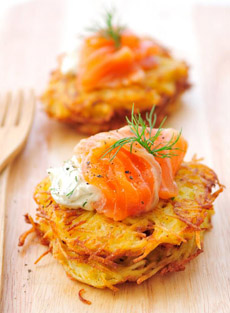
Rosti are a delicious alternative to hash browns and other fried potatoes. Photo by Tanya F. | IST.
|
MALLIKA RAO is an intern at THE NIBBLE. |
|
November 2010
Last Updated September 2018 |
 |
Potato Types
Page 7: Potato Types & Dishes From O To Z
This is Page 7 of a seven-page article. Click on the black links below to view other pages. See our collection of almost 100 great food glossaries.
| Article Index: |
Potato Glossary: |
|
|
This glossary is protected by copyright and cannot be reproduced in whole or in part without written permission. You are welcome to link to it.
Potato Types: O To Z
OKINAWA or OKINAWAN SWEET POTATO
A purple-fleshed sweet potato used extensively in Hawaiian cuisine. The outside is tan in color, similar to a russet potato; but the flesh is a bright magenta color.
Okinawas can be cooked like any sweet potato: baked, boiled, candied, mashed, roasted, scalloped or steamed. Look for them in Asian markets. The Okinawa sweet potato is not related to the purple yam, ube, which is popular in Filipino cuisine and creates dishes of intense purple color.
It is a member of the sweet potato family: order Solanales, family Convolvulaceae, genus Ipomoea, species, I. batatas. Its subspecies is Ipomoea batatas cv. Ayamurasaki.
The white potato is of the same order, but diverges from the sweet potato at that level. The taxonomy of the white potato is: order Solanales, family Solanaceae, genus Solanum, species: S. tuberosum.
|
|
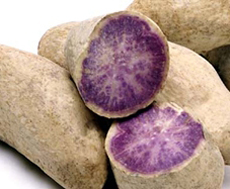
Okinawa sweet potatoes. Photo courtesy Melissas.com.

Baked Okinawa sweet potato “fries.” Photo courtesy Kings Supermarkets. |
POTATO
The potato is a starchy, tuberous crop from the perennial plant Solanum tuberosum, a member of the nightshade family, Solanaceae. The genus Solanum also includes the tomato, among other plants. Potatoes grew wild in the Peruvian Andes, were introduced outside the Andes region 400 ago, and used as hog feed by Europeans for fear they were poisonous like some other members of the Nightshade family. Thanks to the efforts of a French medical officer*, they have become an integral part of much of the world’s cuisine: Potatoes are the world’s fourth-largest food crop, following rice, wheat and maize (corn).
________________
*Convinced that potatoes caused leprosy, the French Parliament banned cultivation of potatoes in 1748. Potatoes as human food had one champion, a French army medical officer named Antoine-Augustine Parmentier. While a prisoner of war, he was forced to eat potatoes and found the “poison” theory simply wasn’t true. In 1772, the Paris Faculty of Medicine finally proclaimed that potatoes were edible for humans, though it took a famine in 1785 for the French to start eating them in earnest.
|
|

An assortment of Idaho potatoes. Photo courtesy J.R. Simplot Co. |
POTATO PANCAKE
See latke.
POTATO SALAD
A popular dish throughout the world, potato salad is a side dish that can be served hot, chilled and at room temperature. Chilled, it is a favorite summer picnic and barbecue dish. Potato salad can be dressed with oil and vinegar, mustard vinaigrette, mayonnaise and combinations of these. It is typically made with boiled potatoes. Additional ingredients can range from apples, bacon, celery, hard-cooked eggs, onions or scallions, even cheese. For potato salad, it is best to choose waxy potatoes low in starch to hold the shape: new potatoes, red-skinned potatoes or white-round potatoes. Here’s a recipe for Mediterranean Potato Salad.
|
|
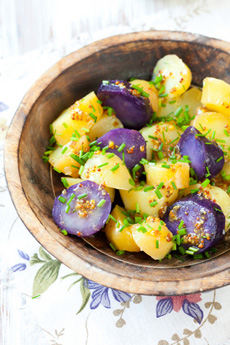
This beautiful potato salad is simple yet sensational: purple and yellow potatoes in a whole-grain mustard vinaigrette with chopped chives. © Svetlana Kolpakova | Dreamstime. |
PURPLE POTATO or PURPLE
PERUVIAN POTATO
Blue or purple potatoes originated in Peru, where the Incas cultivated many varieties of potato (see the history of potatoes). The color can become lavender when cooking. The starch level is medium, so purple Peruvians are an all-purpose potato. They are moist and earthy-tasting, sometimes with a nutty flavor; and the color is very dramatic. Purple potatoes are not only prettier, they have higher levels of polyphenol antioxidants to protect body cells against free radical damage (see this article from NBC News). They can help lower blood pressure, without causing weight gain: guilt-free potatoes! Try these recipes for Peruvian Potatoes With Feta Sauce and Purple Potato & Beet Salad. Also see Okinawa sweet potato.
|
|

Purple Peruvian potatoes. Photo by Mona Makela | IST. |
POUTINE
Poutine is a popular Canadian potato dish, French fries with cheese curd and gravy. It’s the north-of-the-border version of cheese fries with ketchup.
Here’s more about poutine.
|
|

Poutine. Photo courtesy Wendy’s | Canada. |
RED POTATO or RED JACKET POTATO
This group of potatoes, commonly found in supermarkets, have red skin (the “jacket”) and smooth and waxy white flesh. A firm, smooth and moist potato that holds its shape when cooked, reds are best steamed, boiled, roasted or scalloped. They are popularly used in potato salads and gratins. Varieties include the California Red, Huckleberry, La Soda, Klondike Rose and Red Norland. Red potatoes can be substituted for white in any recipe that requires waxy potatoes.
|
|
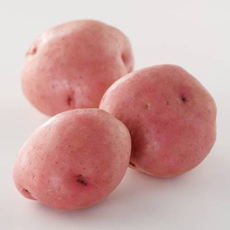
La Soda red-jacketed potatoes. Photo © Idaho Potato Commission. |
ROSTI or ROESTI
Rosti is a Swiss potato dish. It originated as a breakfast dish, but is now eaten for other meals, and is considered a national dish. It is made with fried grated potato, and is usually shaped in a round pie plate and served in a wedge (although smaller, latke-size rosti are made, as in the photo at top of page). Sour cream is a popular garnish, as is a fried egg. Here’s a recipe.
ROUND WHITE POTATO
Round White Potatoes are all-purpose, creamy and have a medium amount of starch. They are available year-round, and keep their shape well when cooked.
|
|

Rosti potatoes. Photo courtesy RecipeTips.com. |
RUSSET POTATO
Russets are the most common type of potato grown in the U.S. They can be called by the generic name Idaho potato (which refers to any floury potato grown in Idaho); there are numerous varieties of russets. The russet potato is oval and has a brown or russet-colored, net-like skin. The skin typically has just a few shallow eyes. Russets are the classic baking potato. |
|

A Russet Norkotah potato. Photo © Idaho Potato Commission. |
RUSSIAN BANANA POTATO
The Russian banana potato has been called the “superstar” of fingerling potatoes. The waxy potato was developed in the Baltic region of the former USSR and is now grown worldwide. It became a favorite potato among discerning chefs, offering a firm, creamy texture and wonderful flavor whether roasted, boiled or steamed.
|
|

Russian banana potatoes. Photo by Claire Freierman | THE NIBBLE. |
RUSSET BURBANK POTATO
Russet Burbank potatoes are the most commonly used potatoes in the U.S. They are grown year-round. With their large, oblong shapes, they are the ideal baking potato. As a floury potato, they are not recommended for making potato salads, because they lose their shape when cooked. Being high in starch, they are light and fluffy when cooked. Their skin is thick and dark brown, low in moisture. It is flavorful and usually left on. Horticulturist Luther Burbank of Massachusetts first developed them in the early 1870s. More growers switched to the variety, which increased in popularity with consumers. Idaho potatoes are Russet potatoes that have been grown in Idaho. |
|

Russet Burbank potatoes. Photo © Idaho Potato Commission. |
SHEPHERD’S PIE
Shepherd’s pie is an English dish similar to a casserole; made from mashed potatoes and ground meat: lamb, mutton, or beef. Its French equivalent is hachi parmentier, made with sauce Lyonnaise—a white wine sauce—instead of brown gravy. Here’s a recipe for shepherd’s pie.
SPANISH OMELETTE
See tortilla de patata, below.
|
|
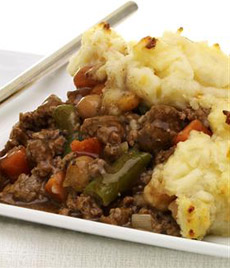
Shepherd’s pie. Photo courtesy McCormick.
|
SWEET POTATO
There are many different shapes, sizes and colors of sweet potato: orange, purple, red and tan varieties can be found. However, none of them is related to the African yam. The sweet potato diverges from the sweet potato at that order level, Solanales. The taxonomy of the sweet potato: order Solanales, family Convolvulaceae, genus Ipomoea, species, I. batatas. The taxonomy of the white potato: order Solanales, family Solanaceae, genus Solanum, species: S. tuberosum. Try this recipe for Sweet Potato Salad.
|
|
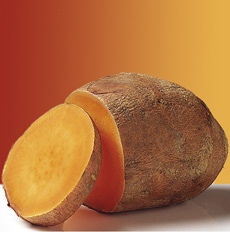
Sweet potato. Photo courtesy 5ADay.gov.
|
TATER TOTS
Tater Tots are an American side dish made from deep-fried, grated potatoes. They are miniature croquettes: crisp little cylinders of hash brown-style potatoes. Tater is American dialect for potato, and “tots” came from their small size. Although the name may seem generic, Tater Tots is a registered trademark of Ore-Ida. Tater Tots were created in 1953 when Ore-Ida founders, brothers F. Nephi Grigg and Golden Grigg, were considering what to do with leftover slivers of cut-up potatoes from their signature French fries. They chopped them up, mixed them with flour and seasonings, and pushing logs of the grated/mashed potato mixture through a form, slicing off and frying small pieces. They began arriving in stores in 1954. The Ore-Ida brand was acquired by H. J. Heinz Compny in 1965.
|
|
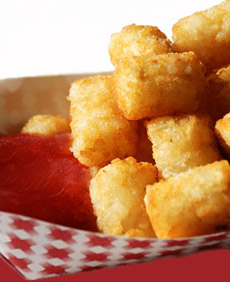 Tater tots. Photo by Marcus Small | Wikimedia. Tater tots. Photo by Marcus Small | Wikimedia.
|
TORTILLA DE PATATA or TORTA or SPANISH OMELET
A typical Spanish dish, tortilla de patata is an egg omelet that incorporates fried potatoes, most often made in a pie pan and served in wedges. It is a common tapas dish and can be served hot, cold or at room temperature.
It is not related to the American “Spanish omelet,” which is a conventional omelet topped with a vegetable-filled tomato sauce.
|
|

Tortilla de patata. Photo by PaperChef.
|
UBE YAM or PURPLE YAM
Yams are from completely different order and family from potatoes, but are included here because of the similarity. Dioscorea alata (family Dioscoreaceae, order Dioscoreales) has flesh that is purple or lavender in color. It should not be confused with two other purple-flesh tubers: taro and the Okinawa sweet potato.
|
|
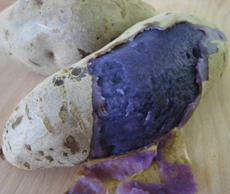
The ube yam. Photo courtesy Burnt Lumpia. |
There are more than 4,000 varieties of native potatoes, mostly found in the Andes. They come in many sizes and shapes. Why are there so many different varieties of each basic potato type? Hybrids were developed to take advantage of different climates and soil types. Growers now have the benefit of getting the highest yields given their topography and microclimate.
As Americans have become more interested in specialty foods, breeders continue to develop new varieties, like the zebra potatoes in the photo.
|
|

Zebra potatoes, grown by Weiser Farms in California. Photo coutesy The Kitchn. |
WAXY POTATO
Due to the low starch levels, waxy potatoes hold their shape well during cooking. When boiled, steamed or roasted, they come out firm and moist—the ideal consistency for potato salad. Some examples are fingerling potato, red potato and white round potato.
|
|

Klondike Goldust potatoes. Photo © Idaho Potato Commission. |
YELLOW POTATO
Yellow potatoes, such as Klondike Gold, Milva, Yellow Fin and Yukon Gold, are all purpose potatoes. They are creamy and dense with yellow flesh, ideal for either mashing or baking. They are also great for frying, and are one of the most popular all-purpose potatoes.
YUKON GOLD POTATO
A prolific, early-maturing, great-tasting golden-skinned, yellow-fleshed potato for baking or mashing. Yukon golds have become a favorite of chefs for their delicious, buttery-rich flavor. They are also smooth—not lumpy. The variety is sprout resistant, so is good for long storage.
YAM
Although even the government uses the terms interchangeably, a yam is not a sweet potato. They are from entirely different botanical families and look nothing alike. The sweet potato (Ipomoea batatas, family Convolvulaceae, order Dioscoreales) is only distantly related to the potato (Solanum tuberosum, family Solanaceae).
|
|
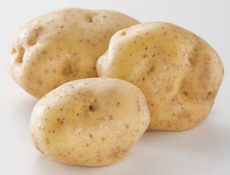
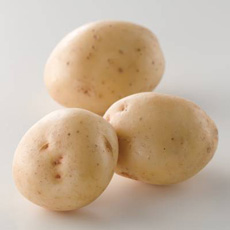
On top, Yellow Fin potato. Immediately above, Yukon Gold potatoes. Photos © copyright Idaho Potato Commission.
|
Unfortunately, sweet potatoes were referred to as yams by growers and grocers, as far back as the 19th century, in order to differentiate the white-fleshed variety of sweet potato from the softer, orange variety. The latter became known as a yam (since real yams are white-fleshed, even the analogy is incorrect). Since real African yams had not yet made it to the U.S., there was no confusion at the time. They became popular in the Caribbean and now can be found in supermarkets that carry tropical produce. Now it’s hard to make people understand the difference between sweet potatoes and yams (but we spell it out for you in detail).
|
|

A section of cut yam. |
Go To The Article Index Above
|

























